Get free scan and check if your device is infected.
Remove it nowTo use full-featured product, you have to purchase a license for Combo Cleaner. Seven days free trial available. Combo Cleaner is owned and operated by RCS LT, the parent company of PCRisk.com.
What kind of malware is AsyncRAT?
AsyncRAT is the name of a remote access or administration tool (RAT). RATs are used to control computers remotely, typically for educational, technical support purposes. In many cases, however, cyber criminals try to trick people into installing these tools to perform various actions on their computers, thereby enabling them to generate revenue.
Typically, cyber criminals attempt to steal personal, sensitive details or infect computers with other malware. Programs such as AsyncRAT can cause serious problems and should be uninstalled immediately.
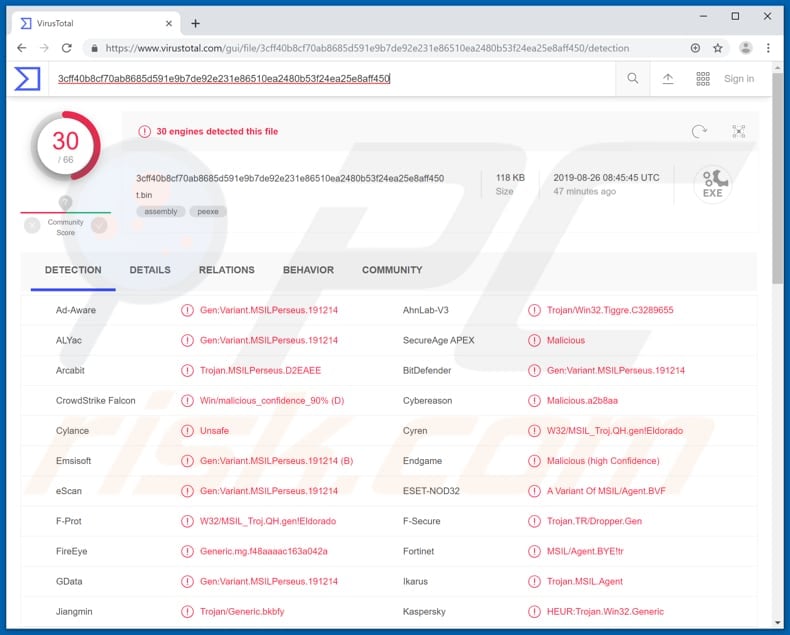
More about AsyncRAT
One feature available in AsyncRAT enables it to open various websites, including malicious sites. Cyber criminals also use it to send various files including, for example, executables. If opened, these can install malicious software. AsyncRAT can be used to proliferate malware such as ransomware, trojans, and other malicious programs.
Furthermore, it allows users to monitor computing activities, access and manage various files (including personal documents), and start/end processes. This RAT can also be used as a keylogger. The keylogging feature can record keystrokes - i.e., log/record keys pressed on the keyboard.
Cyber criminals use this feature steal logins and passwords of emails, banking, and other personal accounts. They use stolen accounts to generate revenue in various ways.
Stolen bank account information can be used to make fraudulent transactions, whilst stolen email accounts can be used to proliferate malware by sending emails containing malicious attachments, also to send scam emails, and so on. Stolen accounts can also be used to extort money from other people (family members, friends, co-workers, acquaintances, etc.).
In any case, logged keystrokes can be used to generate revenue and cause users of infected computers (or other people) financial loss. Furthermore, AsyncRAT can be used to place malicious programs onto USB drives and proliferate them on other computers.
In summary, AsyncRAT is powerful enough to cause computer infections, financial loss, steal sensitive details (causing problems with privacy), unwanted downloads/installations, and so on. If this RAT was not installed intentionally, remove it from your computer immediately.
| Name | Async remote access trojan |
| Threat Type | Remote Access Trojan |
| Detection Names | AegisLab (Trojan.Win32.Generic.4!c), BitDefender (Gen:Variant.MSILPerseus.191214), ESET-NOD32 (A Variant Of MSIL/Agent.BVF), Kaspersky (HEUR:Trojan.Win32.Generic), Full List (VirusTotal) |
| Symptoms | Remote access trojans are designed to stealthily infiltrate the victim's computer and remain silent, and thus no particular symptoms are clearly visible on an infected machine. |
| Distribution methods | Infected email attachments, malicious online advertisements, social engineering, software 'cracks'. |
| Damage | Stolen banking information, passwords, identity theft, installation of other malicious software |
| Malware Removal (Windows) |
To eliminate possible malware infections, scan your computer with legitimate antivirus software. Our security researchers recommend using Combo Cleaner. Download Combo CleanerTo use full-featured product, you have to purchase a license for Combo Cleaner. 7 days free trial available. Combo Cleaner is owned and operated by RCS LT, the parent company of PCRisk.com. |
RATs in general
There are many legitimate and illegal RATs on the Internet. They can be used by cyber criminals for malicious purposes. People are generally unaware that their computers are infected with these programs. The longer they are installed, the more damage cyber criminals can cause through them. Examples of other programs of this type are Poison Ivy, NetWire, and Quasar.
How did AsyncRAT infiltrate my computer?
Typically, people download and install malicious programs when cyber criminals trick them into it. Criminals use spam campaigns (emails), untrustworthy file and/or software download channels, unofficial software updating or activation tools and trojans.
Using "malspam" (spam campaigns), they send emails that contain malicious attachments. If opened, these cause download and installation of malicious programs. Examples of files that can be used to proliferate malware are Microsoft Office documents, executable files (.exe), JavaScript files, archives such as ZIP, RAR and PDF documents.
Another way to proliferate malicious software is through dubious file and/or software download sources. For example, Peer-to-Peer networks (torrent clients, eMule), unofficial pages, free file hosting or freeware websites, third party downloaders and other similar sources.
To trick people into installing malicious software, cyber criminals disguise malicious files as normal and legitimate. Computers become infected when people download and open them. Fake software updaters download and install malicious programs rather than updates or fixes.
In other cases, they infect computers by exploiting bugs/flaws of outdated software already installed on the system. Unofficial activation ('cracking') tools supposedly activate software free of charge and bypass paid activation, however, they often download and install malware.
Trojans are malicious programs that proliferate other programs of this type - if installed, they cause chain infections.
How to avoid installation of malware?
Ignore irrelevant emails that contain attachments or web links, especially those sent from unknown, suspicious addresses. Do not download or install programs using third party downloaders/installers, or the other sources mentioned above. All files and programs should be downloaded from official websites and using direct download links.
Installed programs should be updated using tools or implemented functions that are created by official software developers. The same applies to software activation: 'cracking' tools are illegal and often cause installation of malicious programs. Installed programs should be activated properly.
Keep your computer safe by scanning for viruses with reputable anti-virus or anti-spyware software. Remove any detected threats immediately. If you believe that your computer is already infected, we recommend running a scan with Combo Cleaner Antivirus for Windows to automatically eliminate infiltrated malware.
AsyncRAT administration panel:
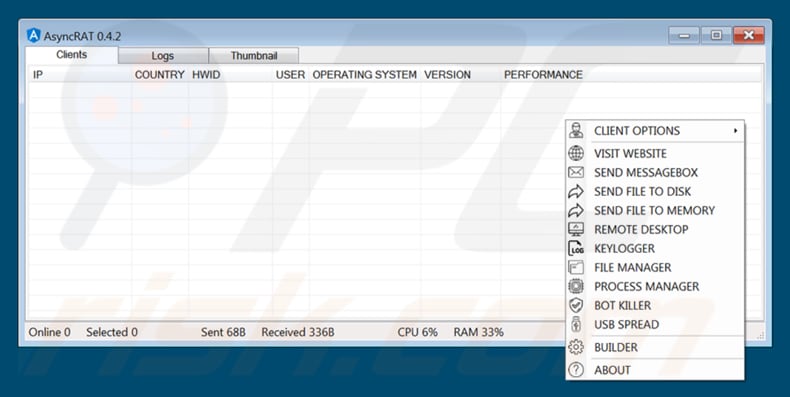
Example of a spam email distributing AsyncRAT (the attachment is "Case No 201605644-45 A2.img"):
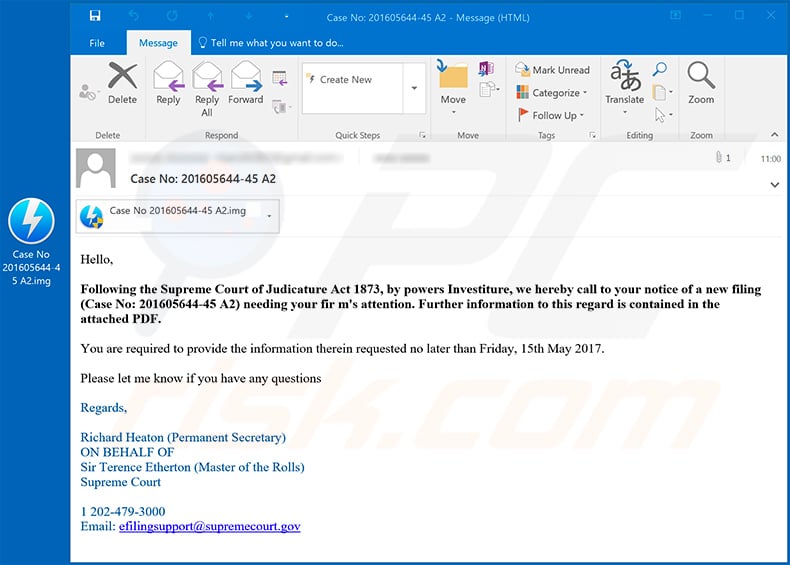
Text presented within:
Subject: Case No: 201605644-45 A2
Hello,
Following the Supreme Court of Judicature Act 1873, by powers Investiture, we hereby call to your notice of a new filing (Case No: 201605644-45 A2) needing your fir m's attention. Further information to this regard is contained in the attached PDF.
You are required to provide the information therein requested no later than Friday, 15th May 2017.
Please let me know if you have any questions
Regards,
Richard Heaton (Permanent Secretary)
ON BEHALF OF
Sir Terence Etherton (Master of the Rolls)
Supreme Court1 202-479-3000
Email: efilingsupport@supremecourt.gov
Additional examples of spam emails used to spread AsyncRAT virus;
Example 1:
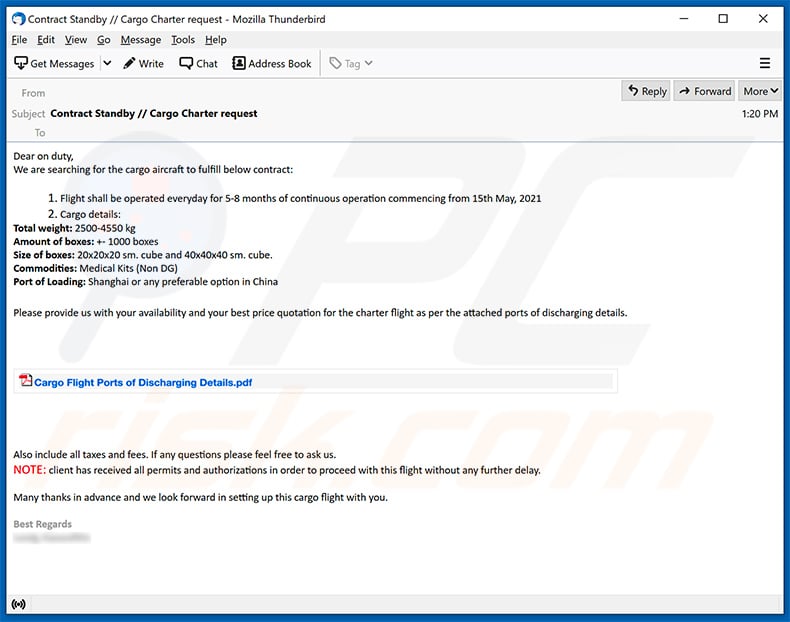
Text presented within:
Subject: Contract Standby // Cargo Charter request
Dear on duty,
We are searching for the cargo aircraft to fulfill below contract:1. Flight shall be operated everyday for 5-8 months of continuous operation commencing from 15th May, 2021
2. Cargo details:
Total weight: 2500-4550 kg
Amount of boxes: +- 1000 boxes
Size of boxes: 20x20x20 sm. cube and 40x40x40 sm. cube.
Commodities: Medical Kits (Non DG)
Port of Loading: Shanghai or any preferable option in ChinaPlease provide us with your availability and your best price quotation for the charter flight as per the attached ports of discharging details.
Also include all taxes and fees. If any questions please feel free to ask us.
NOTE: client has received all permits and authorizations in order to proceed with this flight without any further delay.Many thanks in advance and we look forward in setting up this cargo flight with you.
Best Regards
********
Example 2:
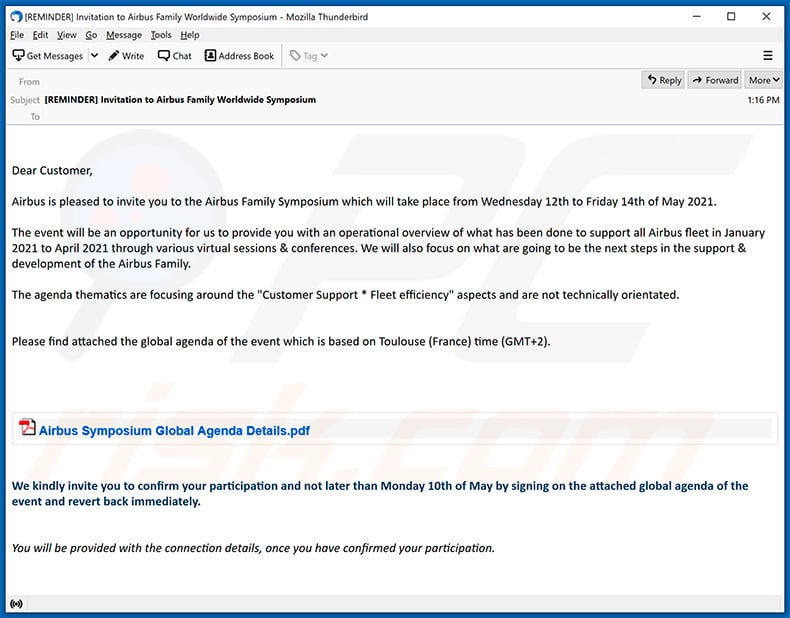
Text presented within:
Subject: [REMINDER] Invitation to Airbus Family Worldwide Symposium
Dear Customer,
Airbus is pleased to invite you to the Airbus Family Symposium which will take place from Wednesday 12th to Friday 14th of May 2021.
The event will be an opportunity for us to provide you with an operational overview of what has been done to support all Airbus fleet in January 2021 to April 2021 through various virtual sessions & conferences. We will also focus on what are going to be the next steps in the support & development of the Airbus Family.
The agenda thematics are focusing around the "Customer Support * Fleet efficiency" aspects and are not technically orientated.
Please find attached the global agenda of the event which is based on Toulouse (France) time (GMT+2).
We kindly invite you to confirm your participation and not later than Monday 10th of May by signing on the attached global agenda of the event and revert back immediately.
You will be provided with the connection details, once you have confirmed your participation.
Screenshot of a malicious OneNote file used to spread AsyncRAT:
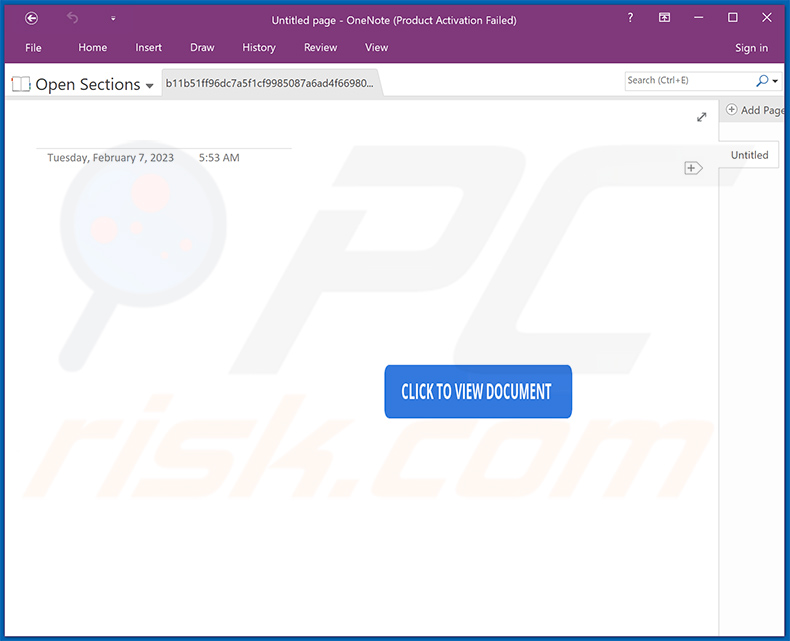
Update 20 February 2023: The latest iteration of AsyncRAT can bypass security measures by utilizing a custom .bat loader, similar to other trojans like URSA. Once the victim falls for the phishing email and runs the undetectable .bat file, the malware then downloads the next stages from an AWS S3 bucket.
These stages include a PowerShell script that generates multiple files to complete the chain, ultimately executing the AsyncRAT.
Update 5 Febryary 2025: A new AsyncRAT malware campaign has been discovered, using Python scripts and TryCloudflare’s service for delivery. The attack starts with a deceptive email containing a Dropbox link, which leads to a ZIP file. This ZIP file contains a shortcut file. After opening this file, other files are downloaded, leading to a malicious Python script.
This script injects AsyncRAT, VenomRAT, or XWorm malware into legitimate processes like notepad.exe, allowing attackers to gain remote access and steal data.
Update September 11, 2025 – new campaign spreading AsyncRAT has been discovered. It revealed vast improvements to the malware's infiltration process and anti-detection techniques. This RAT arrived onto systems after a multi-stage infection chain.
The infection began with a trojanized version of the ConnectWise ScreenConnect remote access program (more on activities that rely on abusing ScreenConnect can be found in our dedicated article). The chain involved several payloads and utilized in-memory processing, thus making the latest AsyncRAT attacks – fileless malware infections.
Instant automatic malware removal:
Manual threat removal might be a lengthy and complicated process that requires advanced IT skills. Combo Cleaner is a professional automatic malware removal tool that is recommended to get rid of malware. Download it by clicking the button below:
DOWNLOAD Combo CleanerBy downloading any software listed on this website you agree to our Privacy Policy and Terms of Use. To use full-featured product, you have to purchase a license for Combo Cleaner. 7 days free trial available. Combo Cleaner is owned and operated by RCS LT, the parent company of PCRisk.com.
Quick menu:
- What is AsyncRAT?
- STEP 1. Manual removal of AsyncRAT malware.
- STEP 2. Check if your computer is clean.
How to remove malware manually?
Manual malware removal is a complicated task - usually it is best to allow antivirus or anti-malware programs to do this automatically. To remove this malware we recommend using Combo Cleaner Antivirus for Windows.
If you wish to remove malware manually, the first step is to identify the name of the malware that you are trying to remove. Here is an example of a suspicious program running on a user's computer:

If you checked the list of programs running on your computer, for example, using task manager, and identified a program that looks suspicious, you should continue with these steps:
 Download a program called Autoruns. This program shows auto-start applications, Registry, and file system locations:
Download a program called Autoruns. This program shows auto-start applications, Registry, and file system locations:

 Restart your computer into Safe Mode:
Restart your computer into Safe Mode:
Windows XP and Windows 7 users: Start your computer in Safe Mode. Click Start, click Shut Down, click Restart, click OK. During your computer start process, press the F8 key on your keyboard multiple times until you see the Windows Advanced Option menu, and then select Safe Mode with Networking from the list.

Video showing how to start Windows 7 in "Safe Mode with Networking":
Windows 8 users: Start Windows 8 is Safe Mode with Networking - Go to Windows 8 Start Screen, type Advanced, in the search results select Settings. Click Advanced startup options, in the opened "General PC Settings" window, select Advanced startup.
Click the "Restart now" button. Your computer will now restart into the "Advanced Startup options menu". Click the "Troubleshoot" button, and then click the "Advanced options" button. In the advanced option screen, click "Startup settings".
Click the "Restart" button. Your PC will restart into the Startup Settings screen. Press F5 to boot in Safe Mode with Networking.

Video showing how to start Windows 8 in "Safe Mode with Networking":
Windows 10 users: Click the Windows logo and select the Power icon. In the opened menu click "Restart" while holding "Shift" button on your keyboard. In the "choose an option" window click on the "Troubleshoot", next select "Advanced options".
In the advanced options menu select "Startup Settings" and click on the "Restart" button. In the following window you should click the "F5" button on your keyboard. This will restart your operating system in safe mode with networking.

Video showing how to start Windows 10 in "Safe Mode with Networking":
 Extract the downloaded archive and run the Autoruns.exe file.
Extract the downloaded archive and run the Autoruns.exe file.

 In the Autoruns application, click "Options" at the top and uncheck "Hide Empty Locations" and "Hide Windows Entries" options. After this procedure, click the "Refresh" icon.
In the Autoruns application, click "Options" at the top and uncheck "Hide Empty Locations" and "Hide Windows Entries" options. After this procedure, click the "Refresh" icon.

 Check the list provided by the Autoruns application and locate the malware file that you want to eliminate.
Check the list provided by the Autoruns application and locate the malware file that you want to eliminate.
You should write down its full path and name. Note that some malware hides process names under legitimate Windows process names. At this stage, it is very important to avoid removing system files. After you locate the suspicious program you wish to remove, right click your mouse over its name and choose "Delete".

After removing the malware through the Autoruns application (this ensures that the malware will not run automatically on the next system startup), you should search for the malware name on your computer. Be sure to enable hidden files and folders before proceeding. If you find the filename of the malware, be sure to remove it.

Reboot your computer in normal mode. Following these steps should remove any malware from your computer. Note that manual threat removal requires advanced computer skills. If you do not have these skills, leave malware removal to antivirus and anti-malware programs.
These steps might not work with advanced malware infections. As always it is best to prevent infection than try to remove malware later. To keep your computer safe, install the latest operating system updates and use antivirus software. To be sure your computer is free of malware infections, we recommend scanning it with Combo Cleaner Antivirus for Windows.
Frequently Asked Questions (FAQ)
My computer is infected with AsyncRAT malware, should I format my storage device to get rid of it?
It is not necessary to format the infected storage device to eliminate AsyncRAT. It can be done by following the instructions provided in our removal guide.
What are the biggest issues that malware can cause?
It can cause monetary loss, data encryption, identity theft, additional computer infections, decreased computer performance, and other issues. It depends on the type of malware.
What is the purpose of AsyncRAT?
This RAT can open websites, download files to a computer (and execute them), manage files, start and end processes, and log keystrokes. Threat actors can use it to distribute malware, steal sensitive information, and other purposes.
How did a malware infiltrate my computer?
It is known that AsyncRAT is distributed via emails containing malicious attachments. Examples of such emails are provided above. Cybercriminals also use cracked software distribution pages, torrent sites, P2P networks, fake installers, and similar methods to distribute malware.
Will Combo Cleaner protect me from malware?
Yes, Combo Cleaner will detect and remove malware. It can detect almost all known malware. When a computer is infected with high-end malware, it must be scanned using a full system scan. Malware of this kind usually hides deep in the system. Thus, it is not enough to run a quick scan to detect it.
Share:

Tomas Meskauskas
Expert security researcher, professional malware analyst
I am passionate about computer security and technology. I have an experience of over 10 years working in various companies related to computer technical issue solving and Internet security. I have been working as an author and editor for pcrisk.com since 2010. Follow me on Twitter and LinkedIn to stay informed about the latest online security threats.
PCrisk security portal is brought by a company RCS LT.
Joined forces of security researchers help educate computer users about the latest online security threats. More information about the company RCS LT.
Our malware removal guides are free. However, if you want to support us you can send us a donation.
DonatePCrisk security portal is brought by a company RCS LT.
Joined forces of security researchers help educate computer users about the latest online security threats. More information about the company RCS LT.
Our malware removal guides are free. However, if you want to support us you can send us a donation.
Donate
▼ Show Discussion